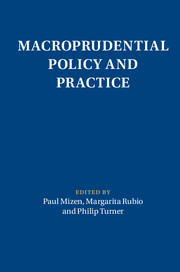Book contents
- Macroprudential Policy and Practice
- Macroeconomic Policy Making
- Macroprudential Policy and Practice
- Copyright page
- Contents
- Contributors
- Introduction
- 1 The Macroeconomics of Macroprudential Policies
- 2 A Liquidity-Based Approach to Macroprudential Policy*
- 3 Financial Intermediation and Monetary and Macroprudential Policies
- 4 The New Art of Central Banking
- 5 The Macroprudential Countercyclical Capital Buffer in Basel III
- 6 On the Use of Monetary and Macroprudential Policies for Small Open Economies
- 7 Capital Flows and Macroprudential Policy
- 8 Macroprudential Policy in a Globalised World
- 9 Systemic Risk of European Banks
- 10 Macroprudential Tools of Systemic Risk Analysis
- 11 When Is Macroprudential Policy Effective?
- 12 Macroprudential Policy
- Index
- References
6 - On the Use of Monetary and Macroprudential Policies for Small Open Economies
Published online by Cambridge University Press: 09 August 2018
- Macroprudential Policy and Practice
- Macroeconomic Policy Making
- Macroprudential Policy and Practice
- Copyright page
- Contents
- Contributors
- Introduction
- 1 The Macroeconomics of Macroprudential Policies
- 2 A Liquidity-Based Approach to Macroprudential Policy*
- 3 Financial Intermediation and Monetary and Macroprudential Policies
- 4 The New Art of Central Banking
- 5 The Macroprudential Countercyclical Capital Buffer in Basel III
- 6 On the Use of Monetary and Macroprudential Policies for Small Open Economies
- 7 Capital Flows and Macroprudential Policy
- 8 Macroprudential Policy in a Globalised World
- 9 Systemic Risk of European Banks
- 10 Macroprudential Tools of Systemic Risk Analysis
- 11 When Is Macroprudential Policy Effective?
- 12 Macroprudential Policy
- Index
- References
Summary
This paper explores optimal monetary and macroprudential policy rules for a small open economy under a sudden reversal of capital flows.1 We consider Taylor-type interest rate rules as a function of inflation, output, and credit growth; and a macroprudential instrument as a function of credit growth. We have two key results. First, in the presence of macroprudential measures, there are no significant welfare gains from monetary policy also reacting to credit growth above and beyond its response to the output gap and inflation. Moreover, monetary responses to financial market developments under both financial and real shocks generate higher welfare losses than macroprudential responses; pointing to the desirability of delegating “leaning against the wind” squarely to macroprudential policy. Second, we find that the source of borrowing is an important determinant of the desirability of alternative policies: the larger the scale of foreign currency debt, the greater the effectiveness of macroprudential instruments. Given the sizable liability dollarization in emerging economies, this finding provides one explanation why macroprudential policies featured so prominently in their response to the 2008–2009 global financial crisis, in contrast to that in advanced economies.
Information
- Type
- Chapter
- Information
- Macroprudential Policy and Practice , pp. 135 - 161Publisher: Cambridge University PressPrint publication year: 2018
